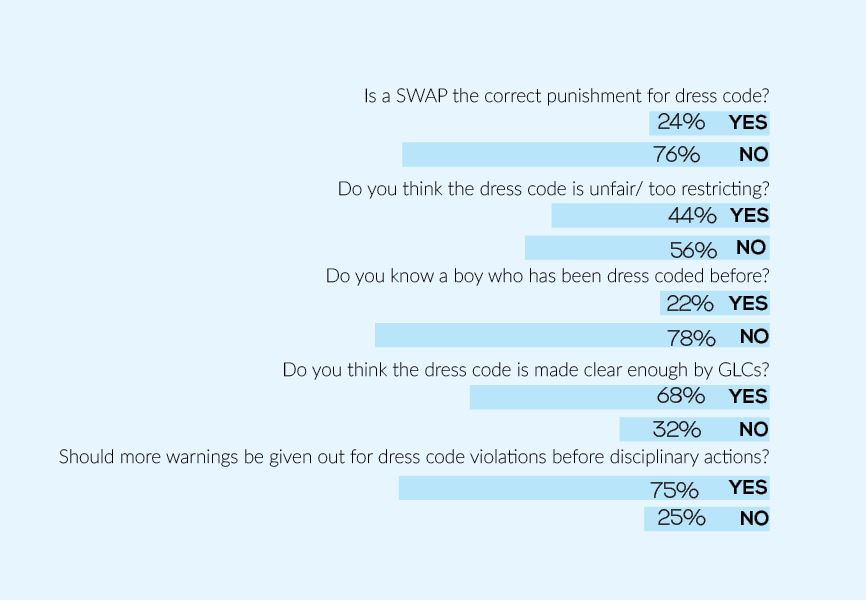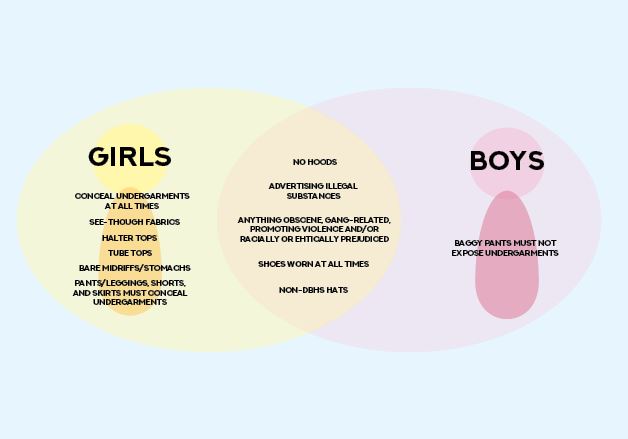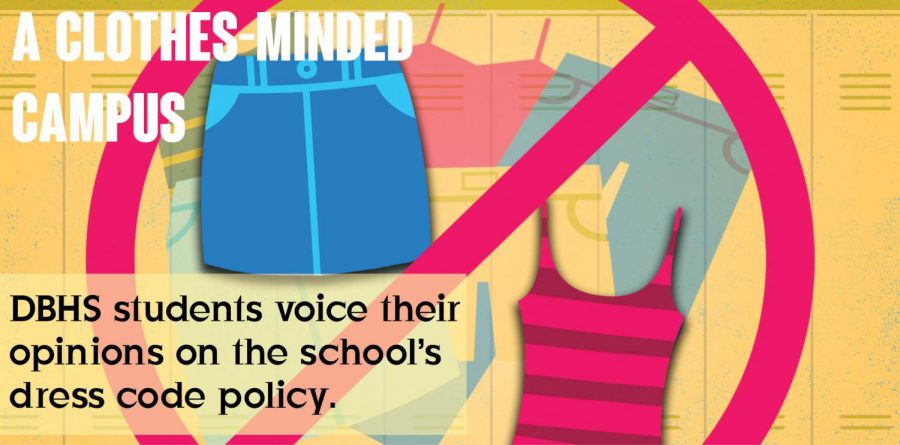Dressed down for dressing up
Students at DBHS are expressing displeasure at the dress code regulations being enforced on campus.


“Excuse me, that is not appropriate for school.” You hear the voice of a GLC and turn around to see a girl wearing a tube top being sent to her counselor’s office, after violating a dress code regulation.
In the halls of Diamond Bar High School, it has become more and more common to see a student in the midst of receiving a dress code violation from a GLC or teacher. Although the issue of dress code is touched upon in the annual GLC meeting with students, there is a rising clash of opinions among students and faculty when it comes to the enforcement of this regulation. When surveyed, 43.9 percent of students believe the dress code has unfair regulations.
The school’s dress code, which can be found on page 14 of the student handbook, states that “each student shall dress in accordance with good standards of health and safety.”
Along with prohibiting clothing advertising illegal substances or the wearing of non-DBHS hats, the policy states that “clothing shall conceal undergarments at all times…halter tops and tube tops (female), and bare midriffs/stomachs are prohibited.”
“If a girl’s shirt is not covering enough, it’s very uncomfortable for not only teachers but for other students too,” senior GLC Ginger Auten said.
Although requests to interview other GLC’s were made by the Bull’s Eye, none of them were available. But a few of them replied that they share the same perspective on the issue as Auten.
Yet, some female students question the logic behind the GLCs’ position, claiming that their clothing or fashion should not be making others uncomfortable.
“If they’re uncomfortable with students wearing things like that, I don’t understand why they would be working at a school,” junior Isabella Carney said.
Another female student also agrees with the reasoning of Carney’s statement, and believes that some of the dress code rules are unreasonable.
“Things that shouldn’t be a problem are made a problem,” said junior Aiziziya Aersilang. “And the consequences are too harsh.”
Auten said she feels that the guidance counselors, as a group, do a thorough job of explaining the dress code’s rules and purpose while clearing up misconceptions of its regulations. However, some DBHS students said they felt that more explanations of the policy is needed beyond the annual GLC meeting during the beginning of the year.
“They [guidance counselors] only briefly skim over it, but start reinforcing it too harshly once they get out of the GLC meeting,” a female senior, who requested anonymity, said.
Other students believe the regulations are confusing and misleading, with 67.2 percent of students polled believing the rules are not made clear enough. It explains why many students believe that the dress code is unfair.
“On the student handbook, it says this and this, but in the presentations, they use completely different examples or say they used a picture to explain something that they didn’t,” junior Jaylene Allen said.
“The dress code is mainly based off of teacher’s opinions rather than actual rules,” Carney said.“They either should give out more warnings or stick to the dress code instead of letting students slide past.”
But perhaps a bigger complaint among students is the differences in gender treatment when it comes to dress code, which have caused numerous students to label these policies as “sexist” and “unfair.” Many female students believe that the dress code is more relaxed for males since they often wear tank tops or muscle T-shirts with oversized armholes that reveal much of their sides but do not get dress coded or warned as often.
In a poll where 198 students were asked if they know of a boy who has been dress coded before, 15.7 percent said no. However, some male students claim dress code regulations are not as lenient on boys as they seem.
“It was hot, so I was wearing a muscle tank, so when the GLC saw me, she told me to go change it,” senior Ricky Kuo said.
Yet a ban against muscle tanks is not listed in any of the dress code regulations in the student handbook.
“I don’t believe that having my shoulders out should be perceived as sexual, and [it] is quite weird and uncomfortable when adults or other people reinforce this, since it suggests that they perceive us in inappropriate ways,” an anonymous female senior said.
Another aspect of dress code that is perceived to be “sexist” are the restrictions on strapless tops and the ban on girls revealing their midriffs.
In spite of this, Auten said that the school is not asking for much from the students on campus since they do not have rules about the specific length or width a tank top strap should be, unlike many other public schools.
Regardless, some female students, such as Allen and Carney, still felt wronged when they were “called out” for wearing halter tops or tops that had a slightly lower cut.
“I understand that it is not asking much from us to wear tops with straps, but I still don’t understand what the purpose of the rule is,” Carney said.
Others believe that the specific rules for girls’ tops are not up to date with today’s fashion and trends.
“I feel like some of the rules for dress code are so outdated,” said Aersilang. “We are mature enough to know what we can wear to school.”
However, one aspect of dress code that both the students and faculty agree on is the fact that girls definitely receive more disciplinary infractions when it comes to dress code violations.
“It’s not biased…but by the nature of clothing that is on sale today, unfortunately it is true that more girls do get dress coded,” Auten said.
She said that boys do get dress coded from time to time for a hoodie, hat, inappropriate graphic on their shirt or muscle tanks, but it just isn’t as often as girls are caught violating regulations.
Aersilang said she received a STAR after being cited for a dress code violation, a situation that she has only seen happen to girls.
Many students who attend DBHS view the school as a place to express their personality or creativity through their daily outfits, and they believe the dress code is stripping this privilege away from them.
“Some of the restrictions on our dress code don’t make much sense to me, and I wish the GLCs could learn to be more lenient when it comes to slight violations,” an anonymous female senior said.
Your donation will support the student journalists of Diamond Bar High School. Your contribution will allow us to purchase equipment and cover our annual website hosting costs.



